Forum d'Avignon
Summary
Online video, social gaming, tablets and e-readers have been among the many contenders to become the “next big thing” in media over the past seven years. Have they lived up to their promise? Has the media industry generated more usage and economic value since 2005? What reasons for hope are emerging today?
For each of the past four meetings of the Forum d’Avignon, Bain has studied how people consume content through connected devices. Our latest global survey of more than 6,000 consumers highlights how innovations remain largely shaped by five underlying trends:
• Abundance: Consumers want to access an “infinite shelf” of content
• Personalization: Consumers are increasingly segmented by their interests
• Aggregation: Fragmented audiences converge toward powerful digital platforms
• Community: Social networks are becoming key to content choices
• Engagement: Consumers are actively involved in content discovery and data curation
Our in-depth look at the state of media and devices across several categories (music, video, books and video games) suggests that this field is as turbulent as ever, with cycles of innovation and reinvention creating a fertile ground for exploring new models. Far from reaching levels of stability or maturity, each of these industries shows strong signs of a seven-year itch, continually on the lookout for the next big thing.
- After years of decline and transformation, the music industry sees hope of recovery in new business models and online aggregators
- Tablets are changing the way consumers watch video, heralding the age of social TV
- The digital migration of the book publishing industry hinges on uncertainties regarding value creation models in Europe and the US
- Video games, once secure on their console model, have been shaken by mobile, Web and “freemium” models
Amid the uncertainty of such cycles of disruption and value creation, we see a set of compelling reasons for hope emerging. Consumers across the world continue to express an ever-growing appetite for content, stimulating new media experiences, including many that bridge creators and consumers in both developed economies and emerging markets. As a result, the content industry is poised to regain its pre-2008 economic value by the end of 2012, driven largely by the emerging markets. Equally important, we see the emergence of a “middle ground” in the media space: a sustainable, diverse market for properties that fills the gap between mass franchises and niche content, which will open new growth opportunities for an industry that has never lacked for new ideas.
2005—2012: Seven years in the digital age
An explosion of new digital models
The past seven years have seen their share of self-proclaimed media revolutions based on smarter devices, more compelling interfaces and new platforms. What lessons can we draw from this explosion of disruptive business models?
The pace of innovation, far from slowing down, has increased over the last few years. Apple took 20 months to sell a million iPods after the device’s introduction in 2001; it sold a million iPads in less than a month in 2010. Facebook has grown from 60 million active users in 2008 to more than 1 billion today, establishing itself in the exclusive league of global platforms alongside Google. And new platforms continue to emerge even faster: Instagram has grown from 10 million to 100 million users in less than a year.
Such competition for consumer attention is not without casualties. In the digital world, just like everywhere else, consumer expectations can be misinterpreted and value propositions deployed at the wrong time or in the wrong place. For example, US household penetration for 3D TVs is only at about 3%—and much less in terms of actual usage—in spite of a strong push from the consumer electronics industry. Two years after its launch, the much-awaited Google TV revolution has captured less than a million households. Even the social space is not exempt from growing pains: 80% of Myspace’s users have left the service, and Apple shut down Ping after only two years.
In our view, those platforms that have become part of the everyday lives of millions of consumers in less than a decade tend to hinge on a set of deeply rooted social, economic and cultural trends, which are the genuine, consistent sources of value creation for the content industry.
Five underlying trends
Five main trends propel the surge of digital platforms that has taken place over the past seven years.
Abundance. Our 2009 study for the Forum d’Avignon identified the end of spectrum scarcity restrictions as one of the driving forces of the media revolution. Consumers who used to have access to only a handful of TV channels, radio stations or books in their library are now overwhelmed with content: hundreds of free and pay-TV channels; iTunes and its 28 million songs, 45,000 movies, 150,000 podcasts and 500,000 applications; Google Books and its 20 million titles. Barely conceivable 10 years ago, access to an “infinite shelf” from which to choose content has become standard. Most consumers view any limits on this wealth of offerings—whether legal or technical—as an insufferable impediment.
Personalization. The ever-increasing segmentation of interests has become pervasive in today’s society. Digital consumers expect content to be tailored to their tastes. In music, smart platforms, such as Pandora, Deezer and Spotify, meet this need by analyzing usage history. According to The Economist, more than 30% of Amazon’s sales in 2011 resulted from its personalized recommendation engine. Today a paradox emerges as demand for personal content continues to grow—fueling the need for extensive data curation—while clashing with rising concerns about privacy.
Aggregation. Facing the daunting prospect of unlimited content choices, consumers feel a growing need for a guide. Audience fragmentation has given rise to powerful aggregators, such as Google and Facebook. Google owes its success to its ability to structure and prioritize digital chaos—if not for giving that chaos meaning. These platforms have become the dominant business model on the Web, raking in up to 60% of advertising spending, sometimes relegating content publishers to mere data sources in the process.
Community. Since even the most sophisticated algorithm could never substitute for a friend’s advice, media usage is becoming increasingly social. Social networks have brought users out of their isolation to rediscover—at least virtually—the pleasure of a shared emotion. By enabling audiences to voice their opinions and share their discoveries, the social Web reintroduces a human element in digital content choices, reconciling the digital space with one of the primary needs of human cultures and societies.
Engagement. Analog broadcasting technologies democratized content and spawned mass audiences. However, these 20th-century audiences were mostly passive. By giving audiences a voice, digital media allows them not only to give their opinion, but also to influence content creation in vivo. Not all consumers are born creators, but they can now play a role in the creative process, even through small acts such as “liking” an artist on Facebook or contributing to a project through a crowdfunding platform such as Kickstarter. Some may see this as a sign of a salutary democratization, cynical demagogy or simply a marketing lever, but it signals a deeper level of personal engagement in the creative process itself. Initiatives such as Talenthouse provide opportunities for the anonymous to express their talents. Millions of participants have already submitted ideas to a community of more than 600 million.
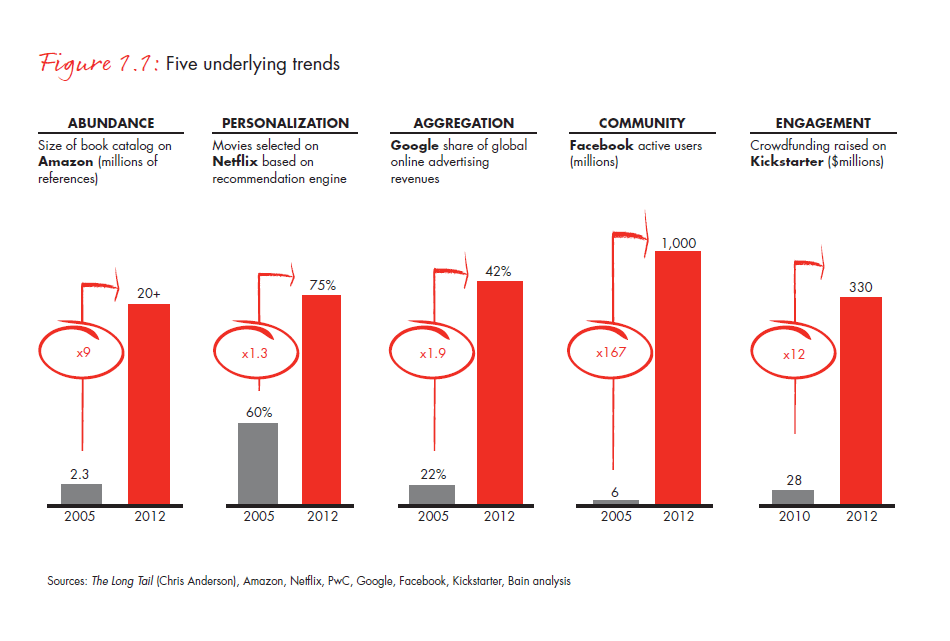
Coming of age
Faced with these trends, different media are following diverse trajectories. Whether in line with expectations or against all odds, they have reached different levels of maturity—and face contrasting futures.
Recorded music: Recovering at last
Just over seven years after the launch of the iTunes store in Europe, nine years after its launch in the US, the music industry may be on the way back to value creation.
Digital sources of recorded music today account for more than a third of time spent listening to music
Recent years have witnessed continuous digital innovation: Music streaming, smart feeds and social interfaces have continued to push digital music toward personalization and community sharing. Today those digital sources account for more than a third of time spent listening to music. Against inherently lower monetization levels, aggravated by lost earnings from illegal downloading, the industry has diversified its revenue sources, as illustrated by the growing importance of live performances and ancillary rights in the industry.
Several signs point to the stabilization of the music industry; for example, in the US digital revenues are poised to overtake physical sales. In this improving but fragile context, high-profile recorded music and publishing mergers, such as Sony/BMG and EMI/Universal, should contribute to strengthening the economic resilience of the industry.
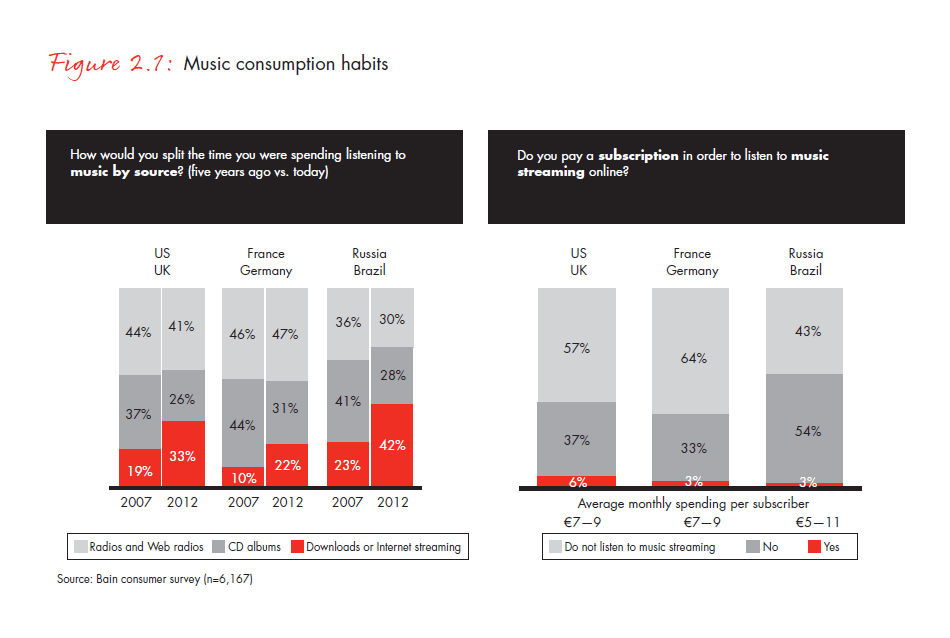
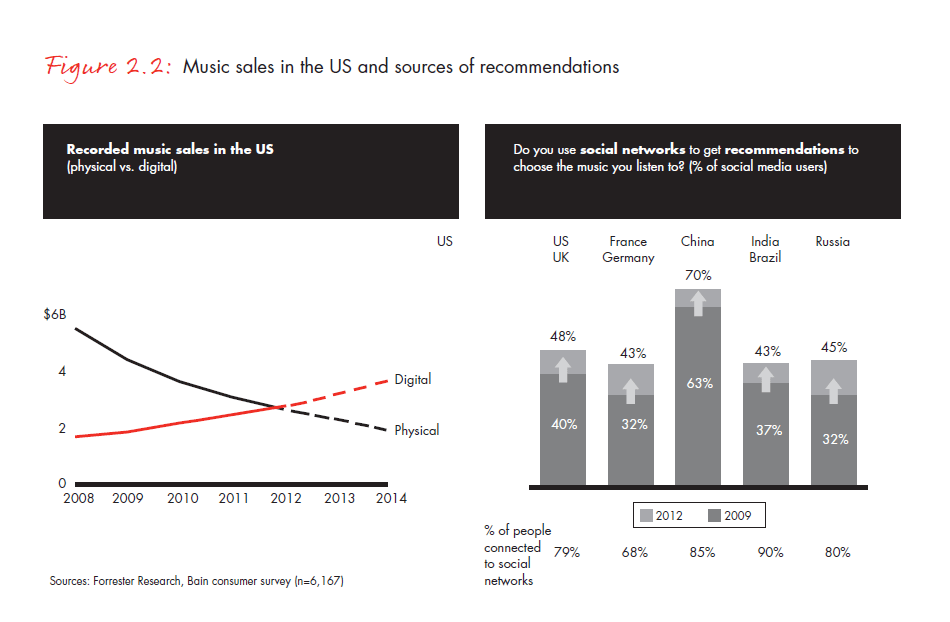
Several signs point to the stabilization of the music industry as digital revenues are poised to overtake physical sales in most mature markets
New equilibriums are emerging for the industry: not only between recorded and live entertainment, but also between mass-market hits and independent and niche properties. While the former remain economic powerhouses, digital platforms and social networks are likely to foster a new breed of artists focused on smaller yet sizable communities of networked fans. Crowdsourcing platforms, such as My Major Company or Minimum
Noise, could become an integral part of the music ecosystem, and an alternative source for majors always looking for new talent. The industry transformation thus goes beyond distribution, as artists and repertoire (A&R) activities fully integrate in the digital age.
Video: Connected devices at the center of a new digital era
Seven years since the birth of YouTube, tablets are changing the way consumers view video and ushering in the age of social TV. Half of French and German households now own an over-the-top video device, such as a console, set-top box or tablet. As a result, nonlinear video now generates significant audiences as it meets the consumer’s need for abundance and customization. YouTube videos receive 4 billion views per day, accounting for nearly half of all videos watched online in the world in 2011. Several of its channels already generate audiences that can compete with cable TV, and its total reach during prime time is already double that of the three largest networks combined in the US. In October 2012, professional Austrian daredevil Felix Baumgartner not only broke the 52- year-old record for a free fall from the highest starting point ever, 128,100 feet, but had a record-setting 8 million-plus viewers tuned in online to the live event coverage on YouTube. The i-generation is becoming the mass market.
While some technologies that were heavily promoted have yet to deliver on their transformational promise—most notably 3D and connected TVs—some major new video platforms have emerged that were hardly anticipated. In particular, consider the rapid adoption of tablets (with 20% of adults in the US and 15% in France) and their heavy skew toward video. They are the new territory to conquer for the video industry. The rapidly growing importance of social networks in video choices and consumption represents another trend that was hardly anticipated a few years ago.
These new video devices and platforms are changing consumer behavior significantly. While 40% of consumers rely on television for their daily video consumption, 40% already use alternative devices—PCs, tablets or smartphones—as well. Half of tablet owners have stopped using television to watch certain types of content, be it news or fiction.
Half of tablet owners have stopped using television to watch certain types of content, be it news or fiction
Social TV is challenging traditional one-to-many content marketing, inherited from analog broadcasting, with social and viral approaches. In the UK, Zeebox allows 1.5 million users to get information about their favorite programs or to see their friends’ comments on their second screen—a tablet or smartphone. Targeted advertising spots also appear on this second screen, contextually linked with those shown on the main screen, and display promotional offers or enable viewers to buy products seen on TV. In France, the new version of the M6 Replay tablet application directly includes social features, allowing users to share and discuss the programs they are watching with their friends and community. Consumer interest is high: Half of surveyed consumers in the US and Europe and two-thirds of those in BRIC (Brazil, Russia, India and China) countries are interested in social video.
New forms of prime time will compete with TV: nonlinear video, video games, social networks
As they stimulate audience appetite for new formats, connected video devices and platforms could unleash the creative energy of content producers. Initiatives such as Condition One’s immersive video, which allows iPad and iPhone users to adjust their field of vision in real time within a recorded movie, is one of many innovation examples.
Yet consumer willingness to pay remains limited, requiring the advertising market to absorb the costs of these new experiences. With more than 60% of households owning at least one connected device by 2015, the very notion of mass audiences, on which the foundations of TV advertising have been built, could evolve. The trinity of prime-time economics—“watch live, watch together, watch regularly”—will become increasingly rare and valuable as audiences continue to fragment. At the same time, new forms of prime time will compete with TV for mass audiences and advertising money: not only nonlinear video, but also video games and social networks. For example, FarmVille, Zynga’s star Facebook game, attracted up to 30 million players per day at its peak.
The battle for aggregation between traditional publishers and networks, search engines and social networks is poised to intensify.
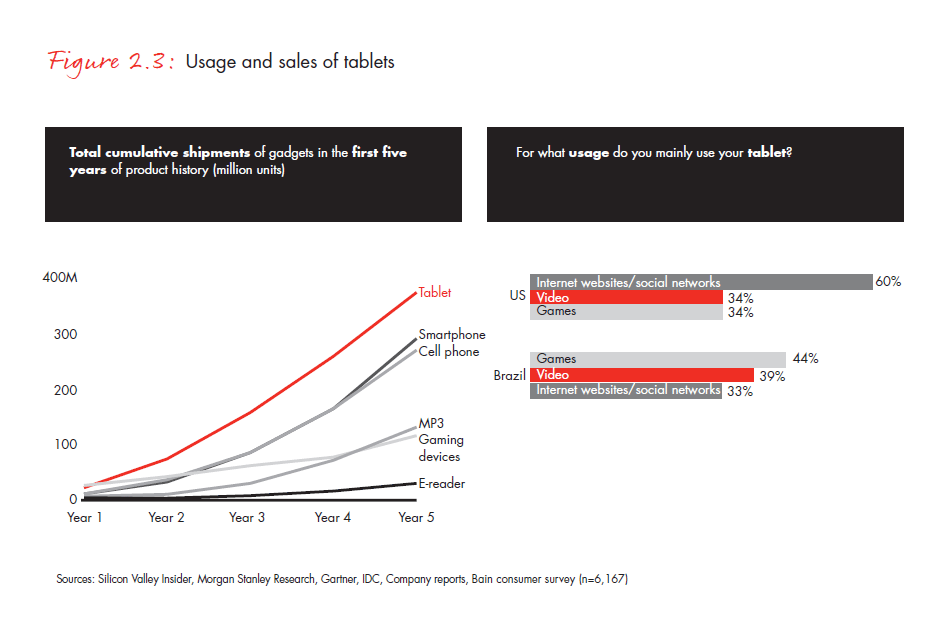
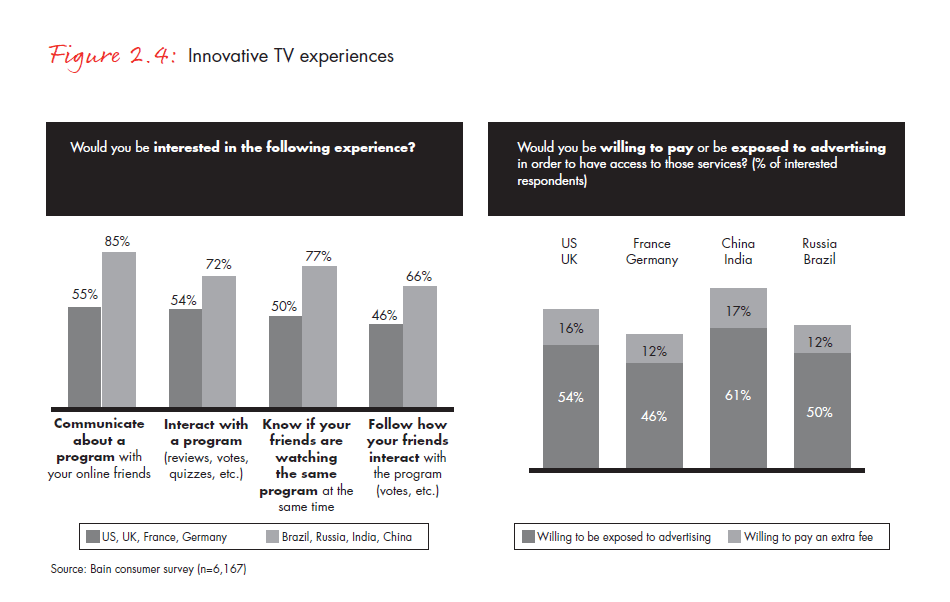
Books: The fragile promise of a value-creating migration
Seven years after the introduction of the first e-readers in the US, the digital migration of the book publishing industry hinges on uncertainties regarding value creation models in both Europe and the US.
The digital transition of book publishing has only really begun in the US and the UK. Several factors have hindered the e-book market in continental Europe and emerging countries, including lower e-reader penetration, consumer attachment to paper and healthier physical distribution networks. Yet purchasing intents suggest that the ongoing democratization of digital reading should continue, benefiting from rapidly declining device prices, especially in BRIC countries.
The digital transition of book publishing has only really begun in the US and the UK
As suggested by our 2010 study, “Publishing in the digital era,” distinct genres have migrated at different paces. Fiction remains the primary e-book genre, with digital representing about 15% to 20% of the total market in the US and the UK. E-reader devices are primarily responsible for this distribution, as tablets are used mainly for Web browsing and video rather than reading e-books, limiting the momentum for color-heavier genres to date.
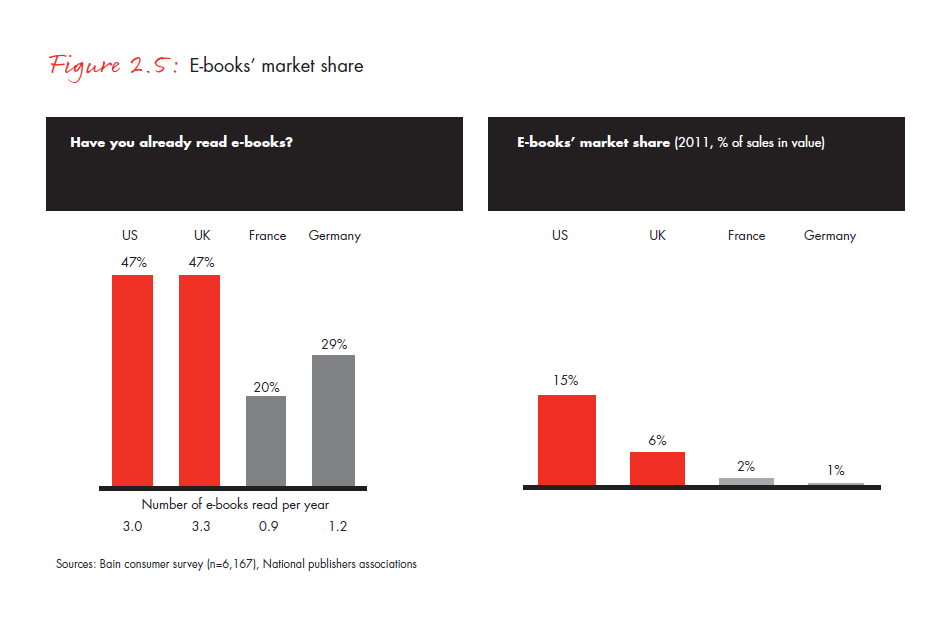
Since most readers continue to pay for e-books, the prospect of a value-creating migration lives on. This willingness should increase as content offerings expand, both in terms of catalog depth and product innovation, in particular for children’s and do-it-yourself books.
New distribution models taking advantage of book dematerialization are being tested—not only in partnerships between authors and digital platforms, but also in self-distribution. For instance, J.K. Rowling launched Pottermore, an exclusive digital publishing and distribution platform for the Harry Potter franchise. Likewise, self-publishing and crowdfunding websites are burgeoning around the world, allowing readers to decide for themselves whether a book is worth publishing. For example, Bibliocratie.fr allows readers to provide input on book prices. Unbound.co.uk offers content and product benefits to readers “investing” in a book. Bookly.fr even allows consumers to invest in the book they like and share future earnings with the author.
The fragile economic balance for publishers continues to depend on a sensitive regulatory framework on prices and VAT
Confronted with this profusion of models, publishers and distributors remain essential, although they face many challenges. Fragmentation of independent platforms illustrates the challenges of competing with global players such as Google and Amazon. The fragile economic balance for publishers, already highlighted by our 2010 study, continues to depend on a sensitive regulatory framework on prices and value-added tax (VAT), which will be closely scrutinized by regulators across the world.
Finally, consumer appetite for new multimedia, interactive and social formats primarily hinges on publisher innovation. Interesting products can already be found, especially in do-it-yourself, children’s and school books. The latter category likely represents the key to a real generational shift in e-book usage. Not insignificantly, Apple introduced the second version of its iBooks platform in January 2012, allowing the integration of interactive illustrations, 3D schematics, audio and video, with a clear focus on textbooks. Illustrated and school books could also represent an attractive test bed for new business models based on subscriptions and advertising. Our research finds that 70% of e-reading consumers in BRIC countries and 50% in Europe would be interested in economically attractive e-book subscription services.
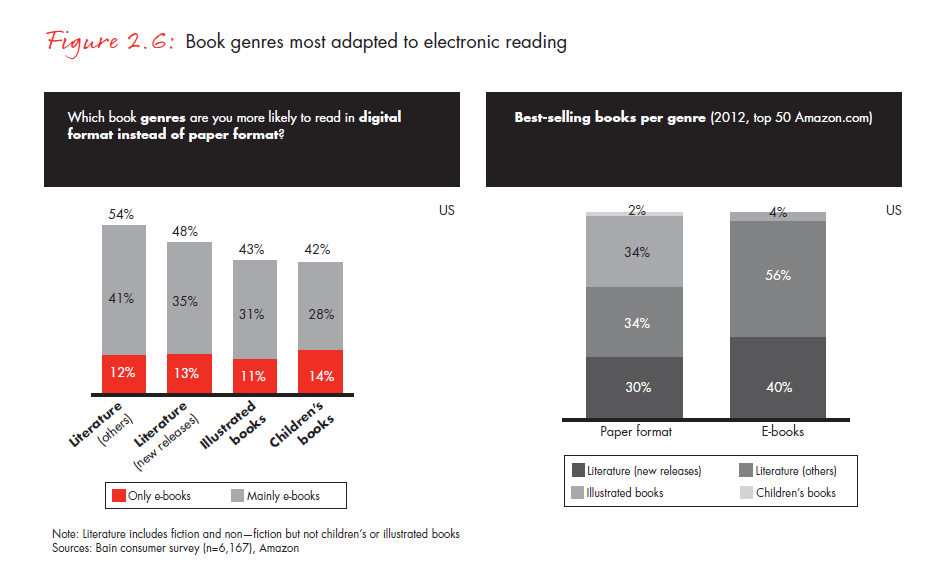
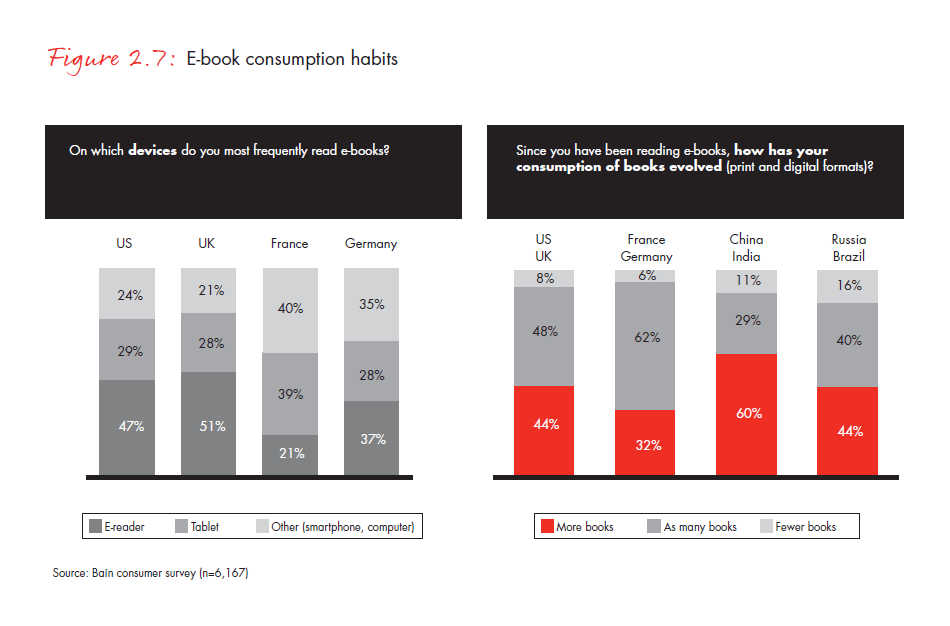
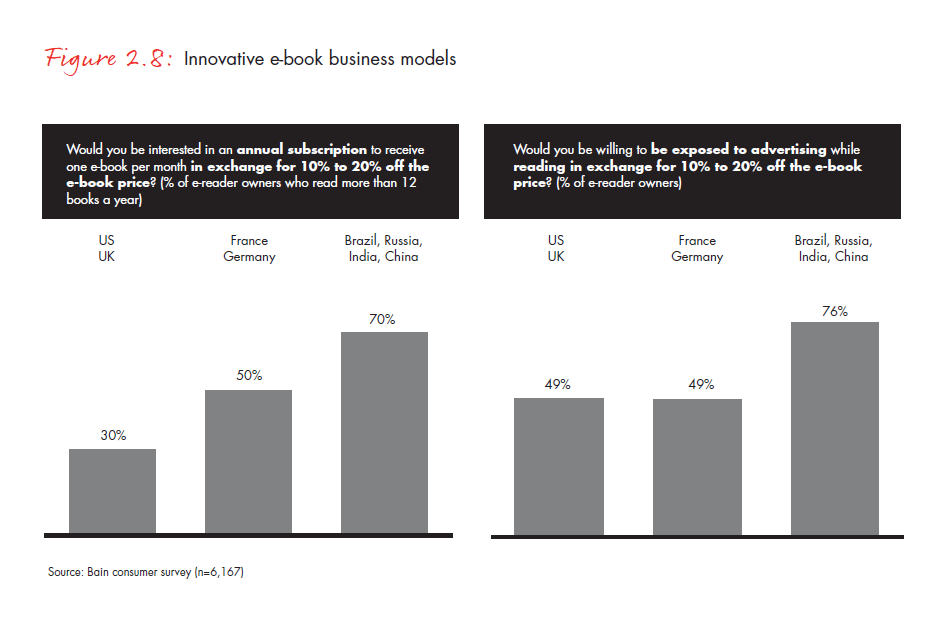
Video games: The transition of a digital-native industry
The supposedly “digital-native” video game industry, which has thrived on a platform of online consoles and massively multiplayer online games, is currently being shaken up by mobile, Web-centric and freemium models.
Connected consoles will penetrate up to 30% of households by 2014
Our consumer survey suggests that connected consoles will penetrate up to 30% of households by 2014. More importantly, the emergence of smartphones, tablets and social networks as gaming platforms has dramatically broadened and altered the industry’s user base. Today, titles such as Angry Birds and its billion downloads compete with traditional industry blockbusters for consumer attention.
Casual gaming should benefit from democratization of new gaming devices
Gamers who play on new and portable gaming devices spend more than one-third of their gaming time on casual games, mostly on social networks. Yet their willingness to pay on such platforms remains structurally lower—inducing a long-term shift toward lower-value and freemium models. In parallel, the next generation of consoles should revitalize the core gaming segment—at the cost, however, of ever-higher development budgets. Cloud gaming, promising to stream high-production value games on simple connected devices, such as TVs and smartphones, should further this trend, accelerating the obsolescence of physical distribution at the cost of heavy digital infrastructure. This model remains unproven today, as suggested by the financial troubles of cloud-gaming pioneer OnLive and the recent buyout of Gaikai by historical industry leader Sony. Yet it is likely to dramatically alter the established economic balance between hardware manufacturers, software publishers and distributors.
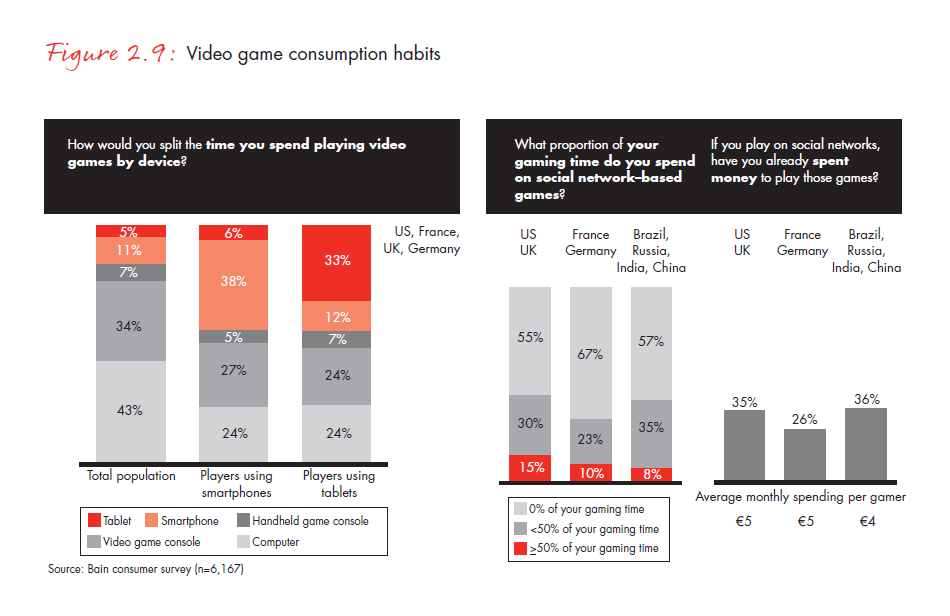
Somewhere between independent casual wonders and billion-dollar blockbusters—worldwide sales of Modern Warfare 3 took only 16 days to reach $1 billion, a day less than the 2009 blockbuster film Avatar took to reach the same milestone—the industry faces an imperative to innovate. Recent growth markets, such as women and seniors, may be reaching their limits already, as the recent decline of the family-friendly Nintendo Wii suggests.
In this context, ongoing market consolidation is likely to continue as traditional players adapt; for example, consider EA’s acquisition of casual powerhouse PopCap in 2011. Publishers also have to develop new capabilities: Community managers now work alongside developers and graphic designers, and writers integrate customer feedback into creative choices as games shift to episodic content. More than ever, publishers need to invest in ambitious content and brands to withstand market changes.
Creating value(s) in the digital age
From ubiquity to diversity: The road to economic recovery
Digital platforms not only increase the depth of content available to consumers but also stimulate their interest in new experiences. Satisfying this appetite is a daunting challenge for content producers, as well as a major opportunity for traditional publishers and digital platforms to become the curators of the digital chaos.
Combined with infrastructure improvements in emerging markets, the development of global content platforms and social networks could facilitate exchanges among audiences and creators, fostering the transmission of content and ideas across the world.
While our 2009 study anticipated a return to pre-crisis economic value levels by 2013, our latest forecast confirms this recovery, with emerging markets as the driving force.
At the same time, growth dynamics between distribution and content aggregation have reversed since our 2009 study. While distribution, led by telecom and cable operators, was the clear winner of the first digital decade, we expect its share of the total media value pool to begin receding as digital aggregation models ramp up. In seven years, online has jumped from marginal to more than 20% of the industry’s profit pool.
Against such long-term trends, we see a pattern of cycles. In recorded music in the US, digital sales will soon overtake physical ones, signaling the prospect of a return to growth. Meanwhile, the video game and book industries, which have been largely spared by digital disruption to date, are beginning to experience what could become structural changes. These are only a few examples of the media industry reacting to external, technology-driven shocks through successive waves of adaptation and reinvention.
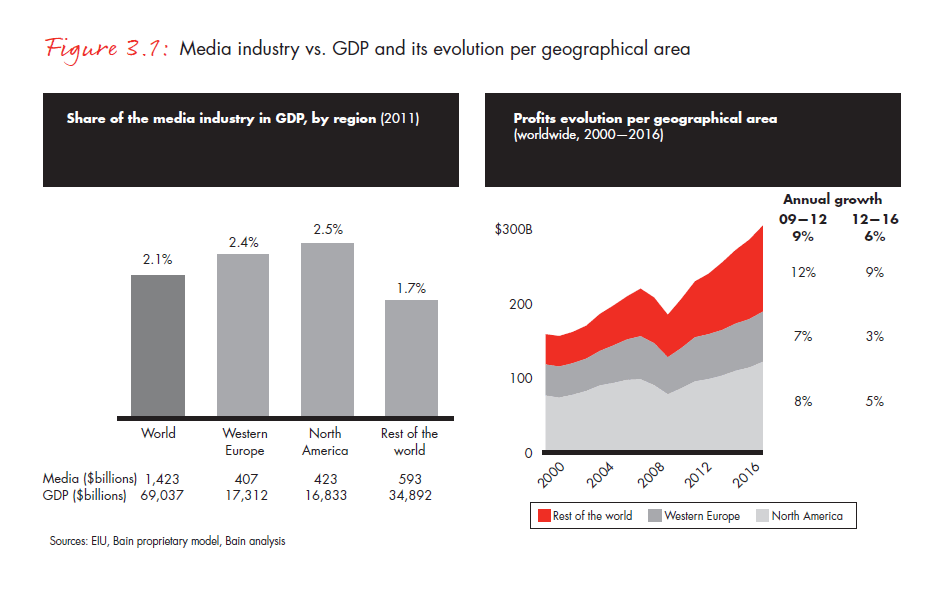
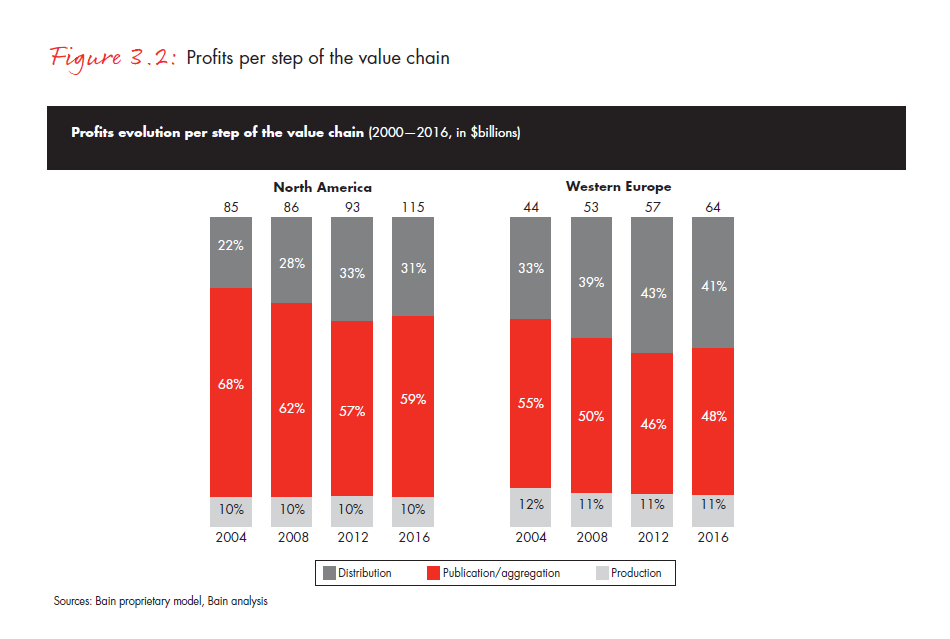
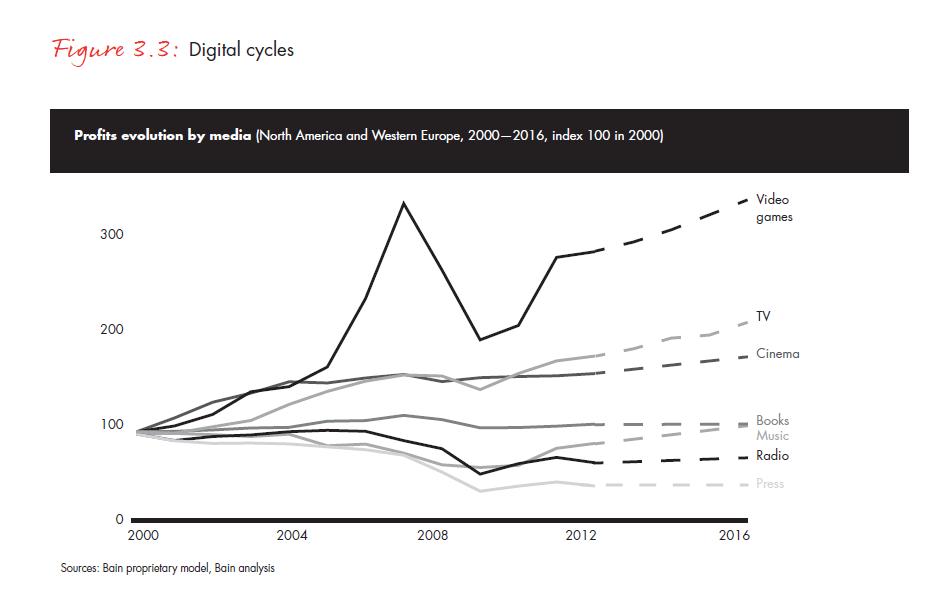
The rise of a creative middle ground
Recent history in television, music and box office suggests an ongoing rebalance between large blockbusters and niche content
By lowering historical barriers to creation and distribution, digital platforms offer new opportunities to develop and deliver content to segmented audiences. Recent history in television, music and box office suggests an ongoing rebalance between large blockbusters and niche content, resulting in the emergence of a profitable middle ground in the content industry.
For example, the average box office sales of the top 10 movies in France decreased by 27% from 1998 to 2010, while box office sales for movies ranked 11 through 100 nearly doubled over the same period. A similar decline of blockbusters can be observed in recorded music, where top 10 album sales in the US fell by 60% in 10 years, much faster than the overall market. This ongoing shift can only be further reinforced by new distribution platforms and social communities, which have demonstrated their ability to deliver virally targeted content to mass audiences.
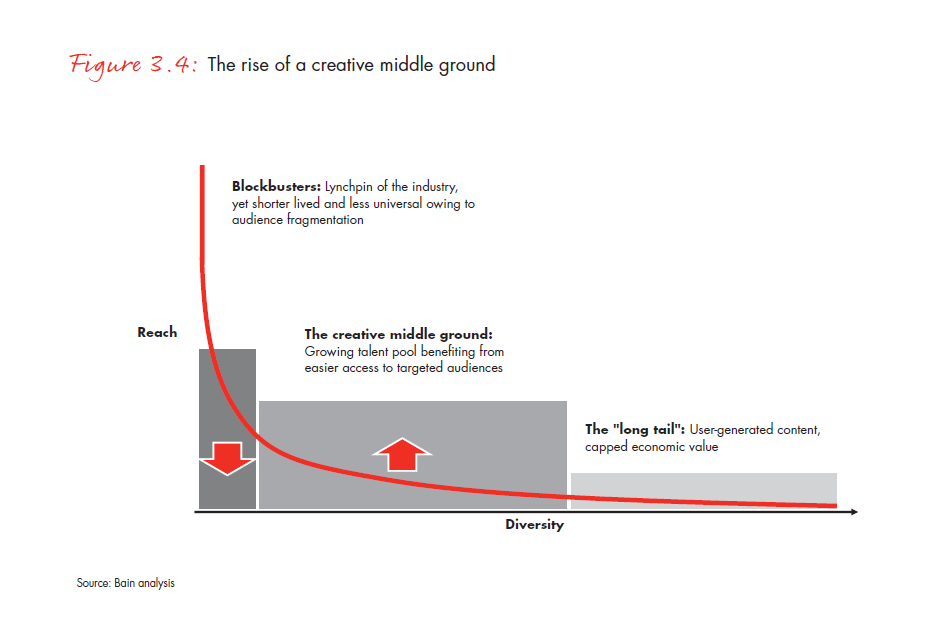
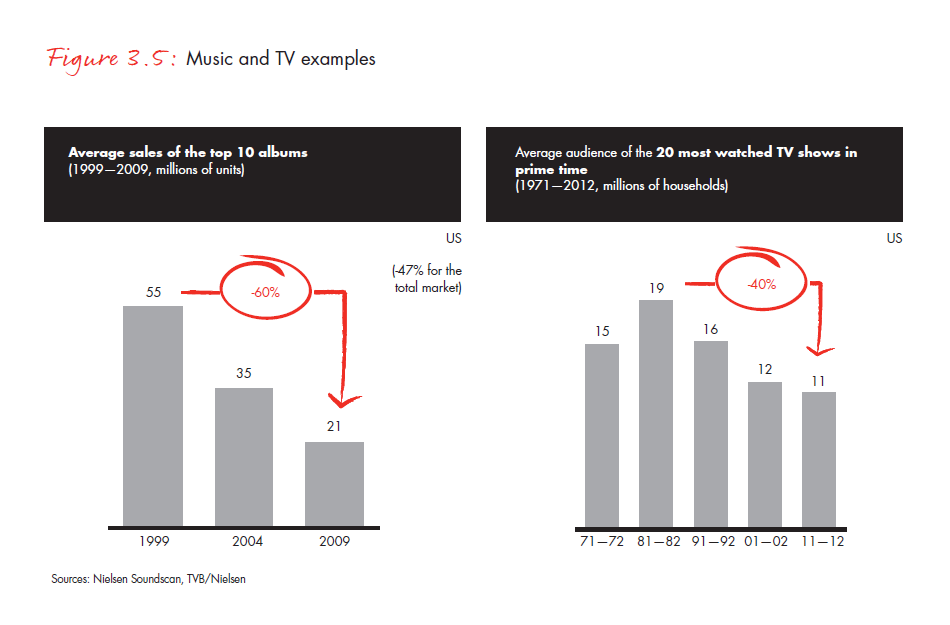
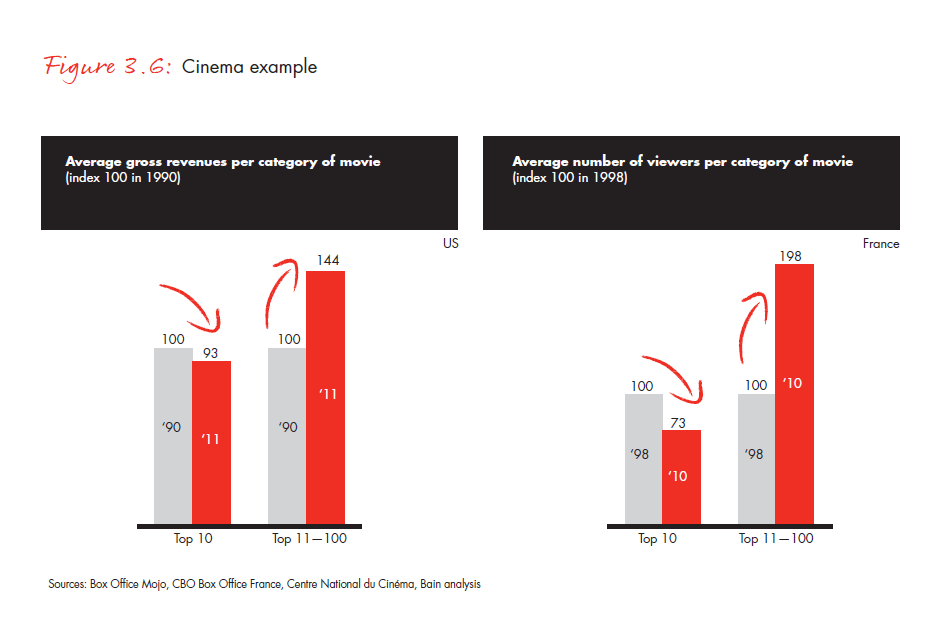
For this nascent trend to live up to its promise, the many stakeholders in the content ecosystem will have to take up several challenges.
Commercial platforms, confronted with the explosion of digital cultural products and services, and what it offers and demands, will continually have to reinvent business models that blend new consumer needs with creative innovation.
Regulators will face the demanding task of adapting legal frameworks to fast-paced innovation, both in terms of technology and business models.
And artists, while enjoying more creative resources than ever, will have to manage the daunting prospect of receiving direct, continuous audience feedback; develop their own marketing and social media skills as a complement to those from labels and other professionals; and face emerging competition from a wider range of talent.
Successfully and simultaneously addressing such imperatives represents a formidable challenge for the media industry, but bears the promise of an equally formidable prize. Make diversity its primary value creation engine for the next seven years.
Patrick Béhar is a senior partner with the Paris office of Bain & Company and leads the firm’s Media & Entertainment practice in Europe, the Middle East and Africa. Laurent Colombani is a partner with the Paris office of Bain & Company, managing its French activities.
Appendix: survey results
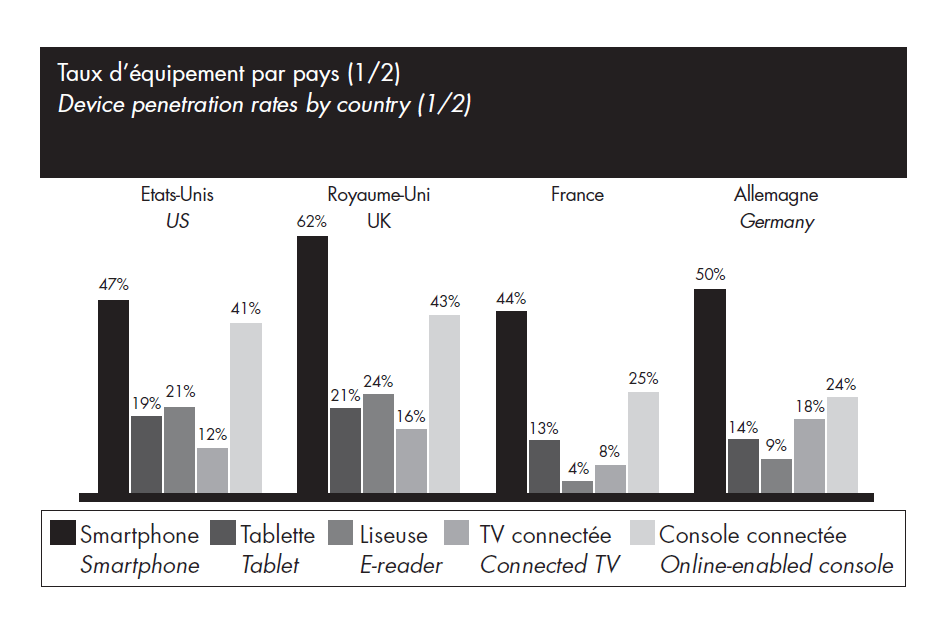
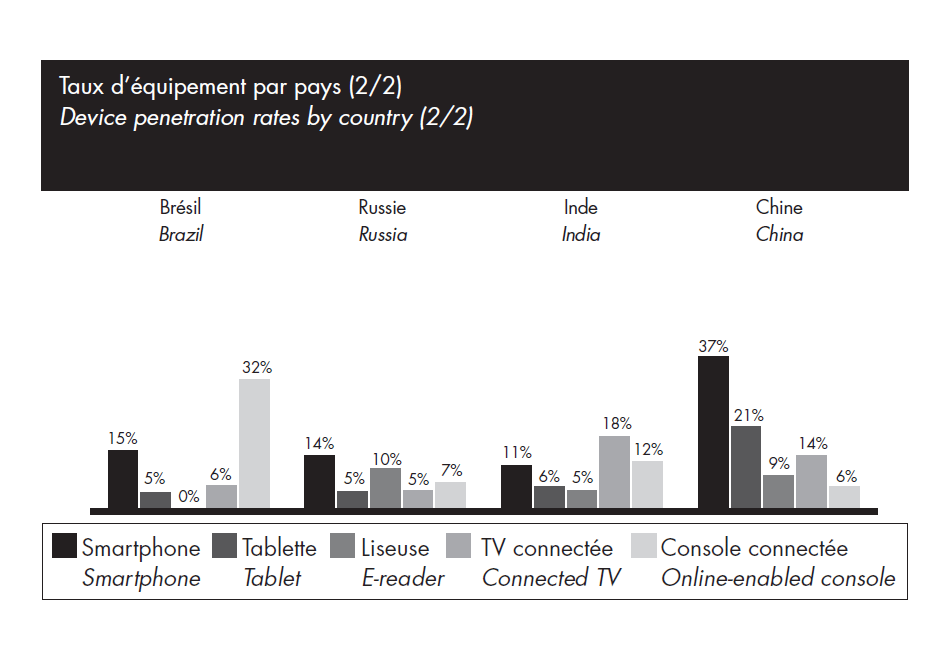
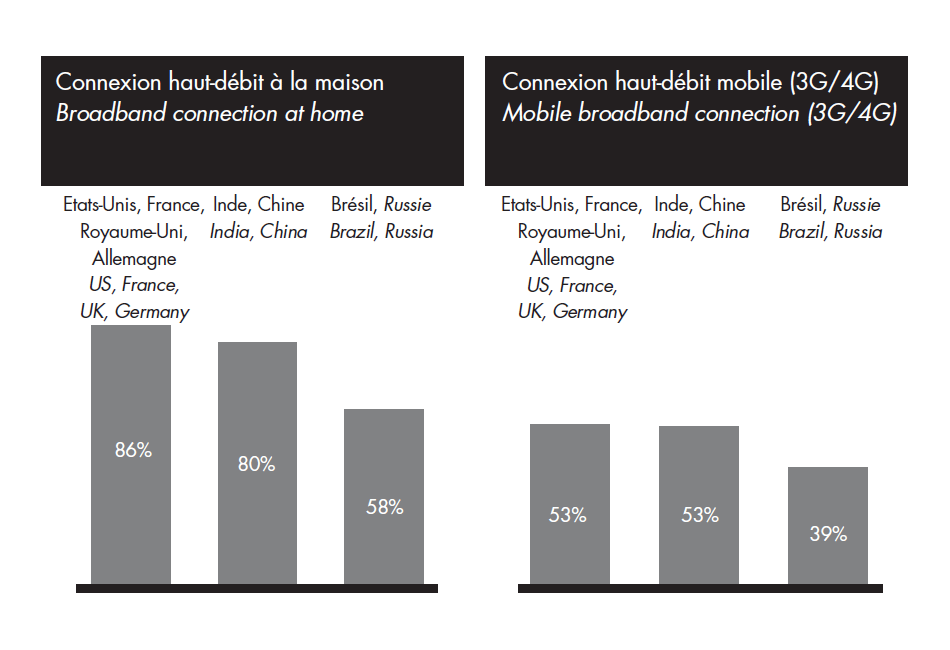
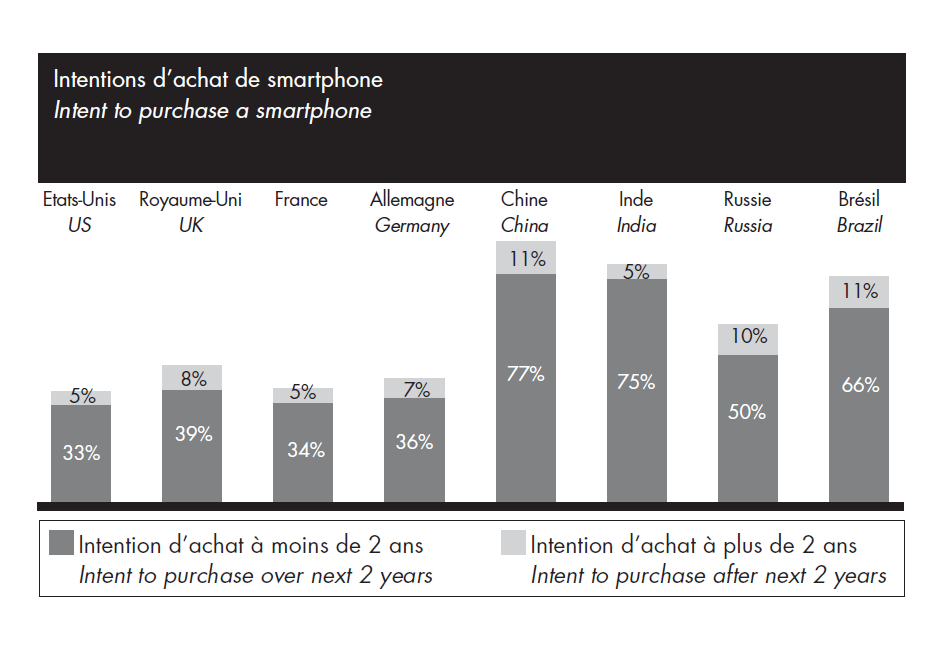
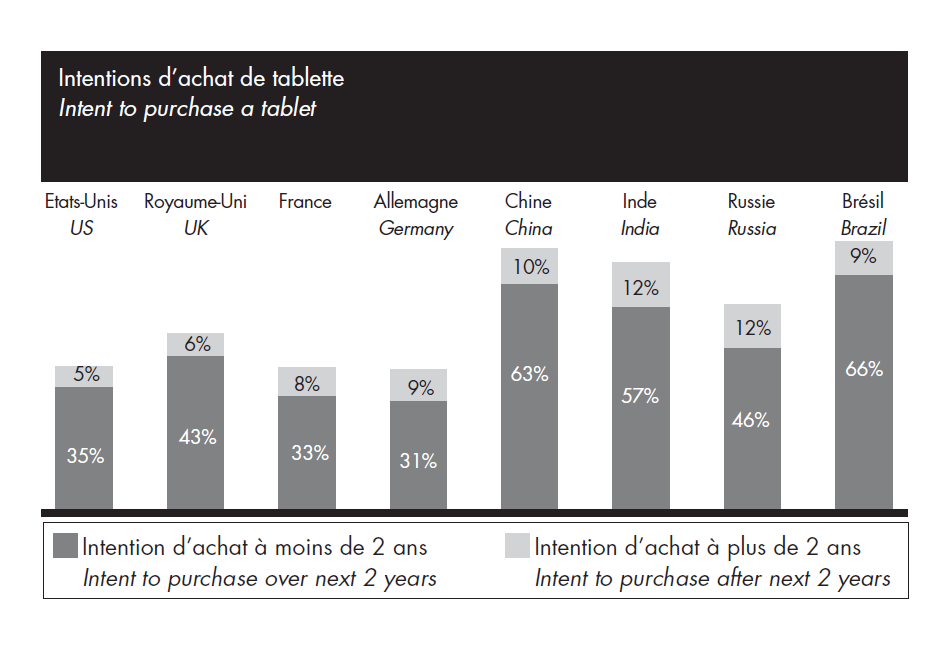
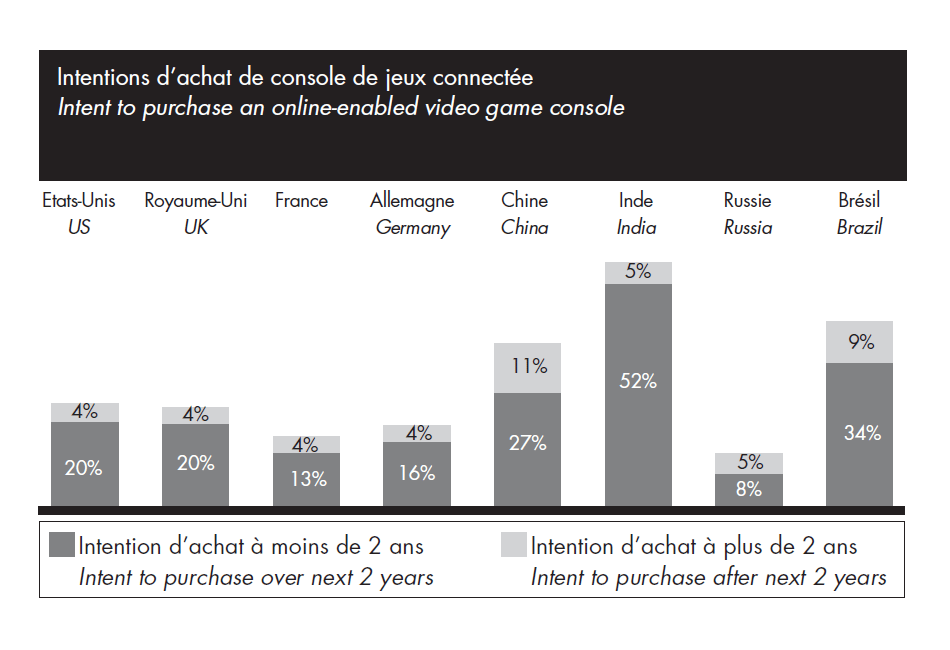
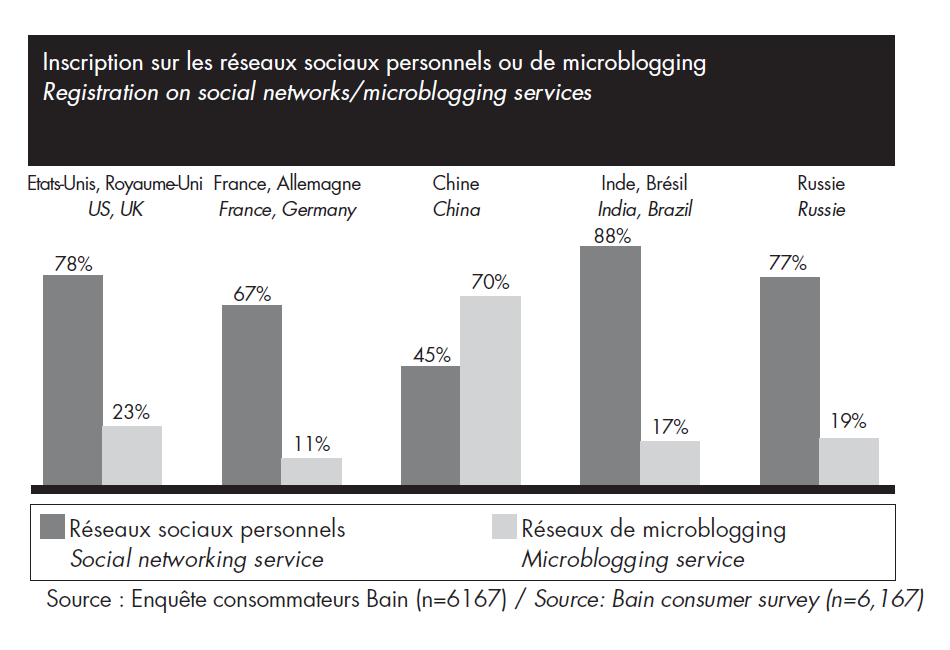
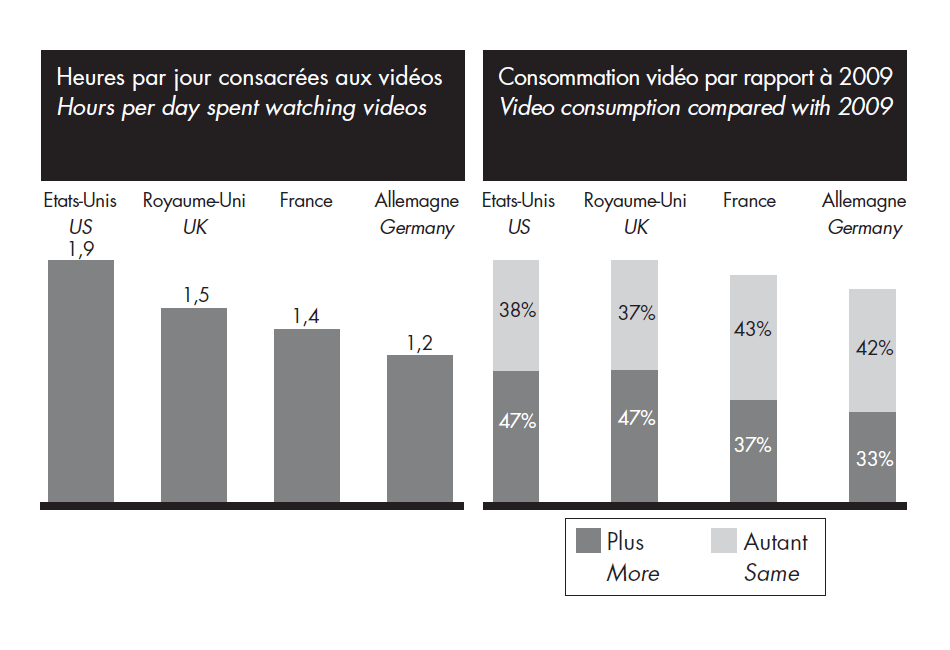
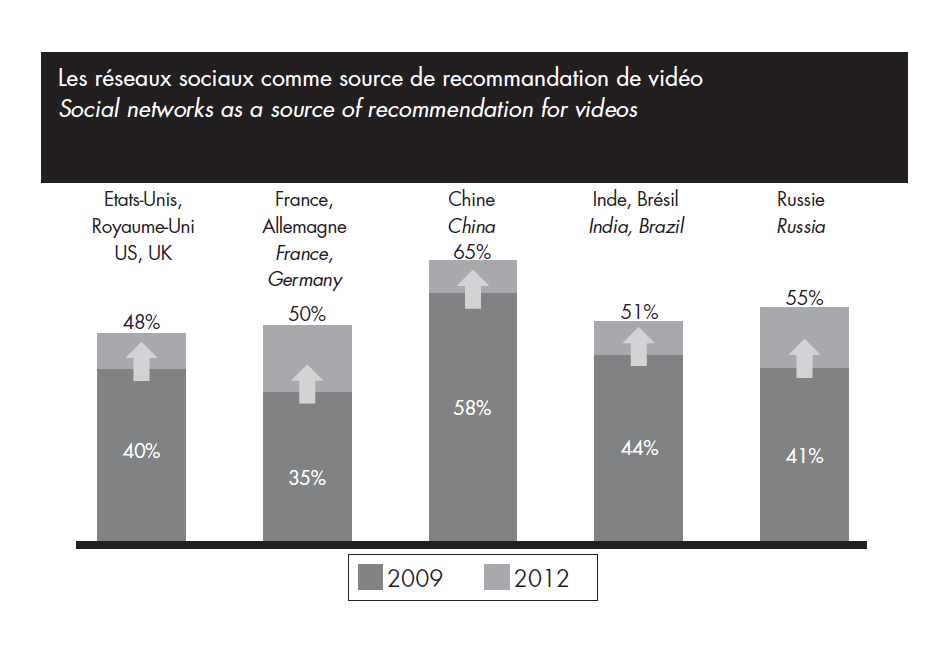
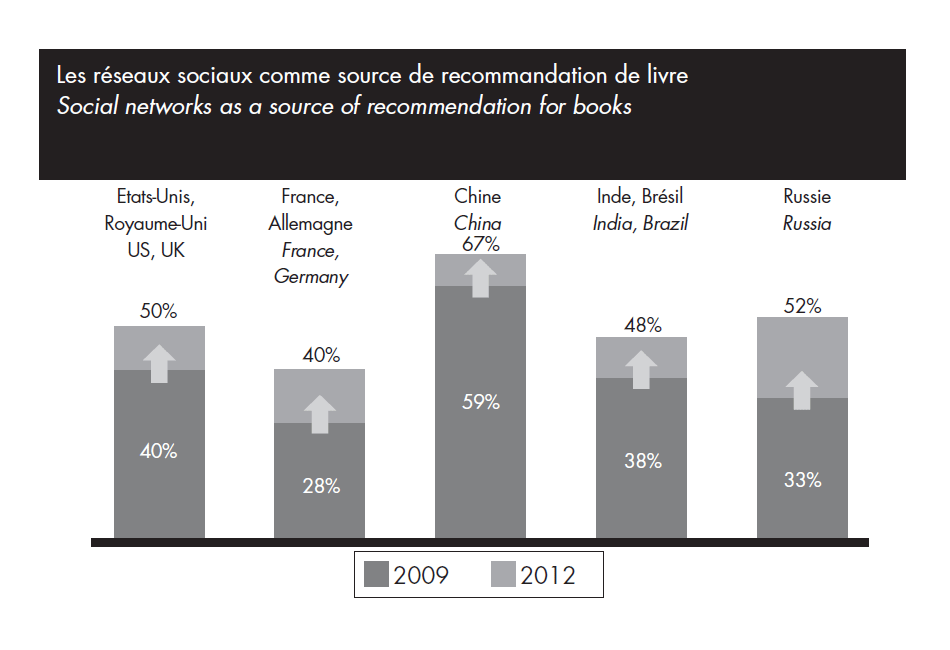
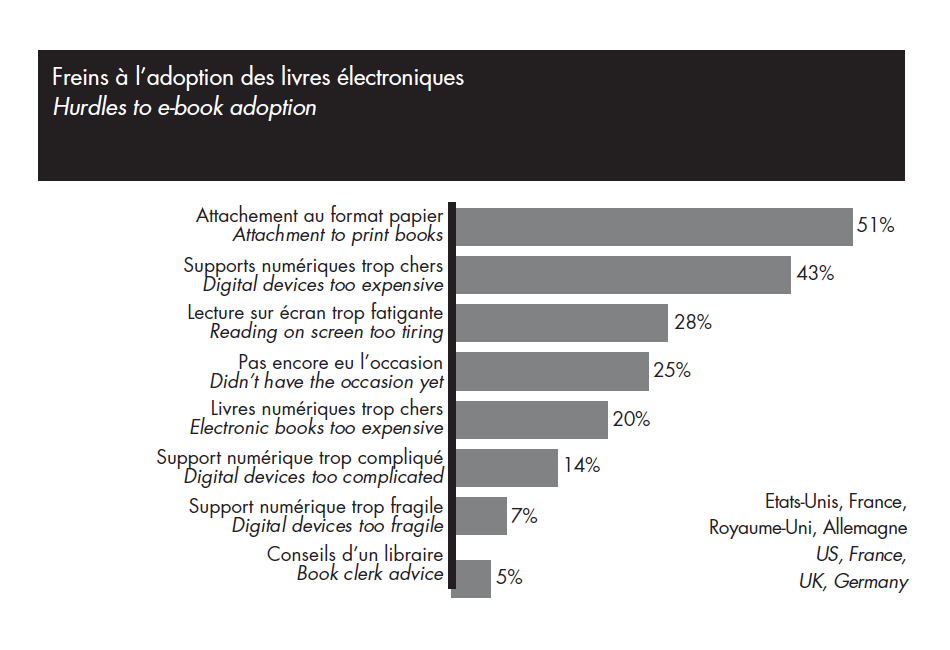
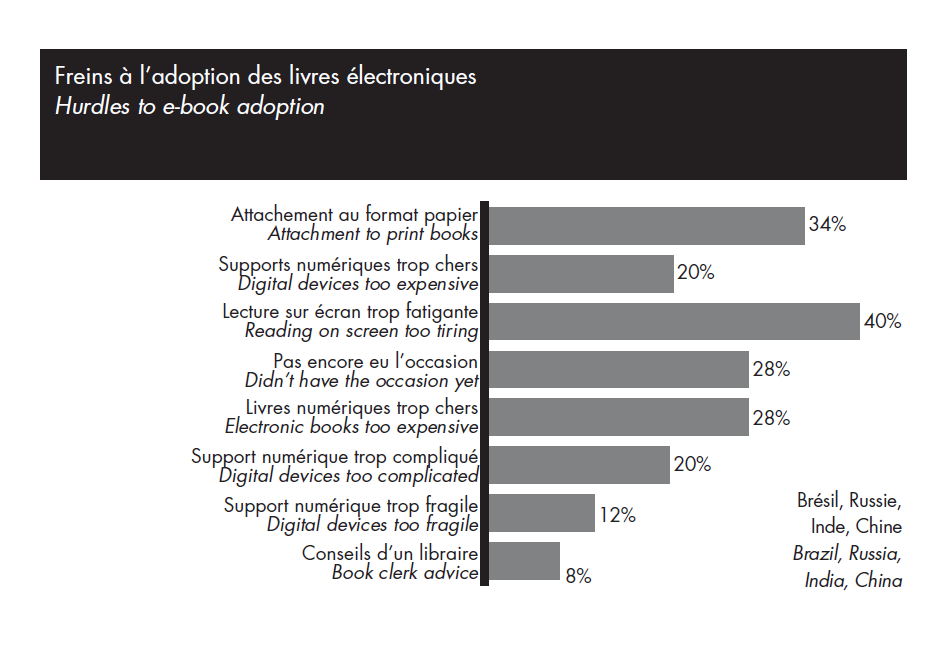
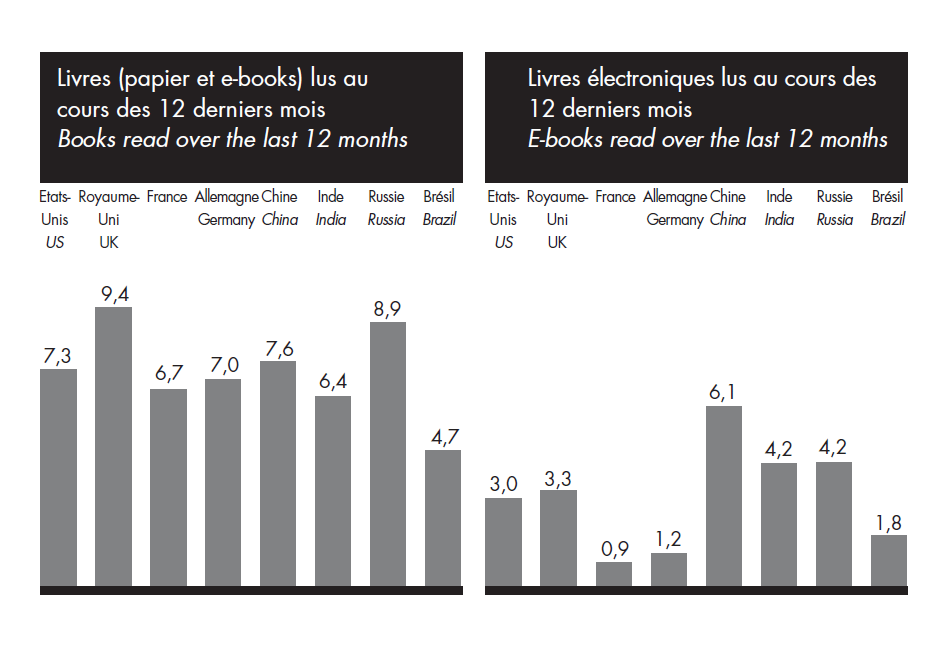
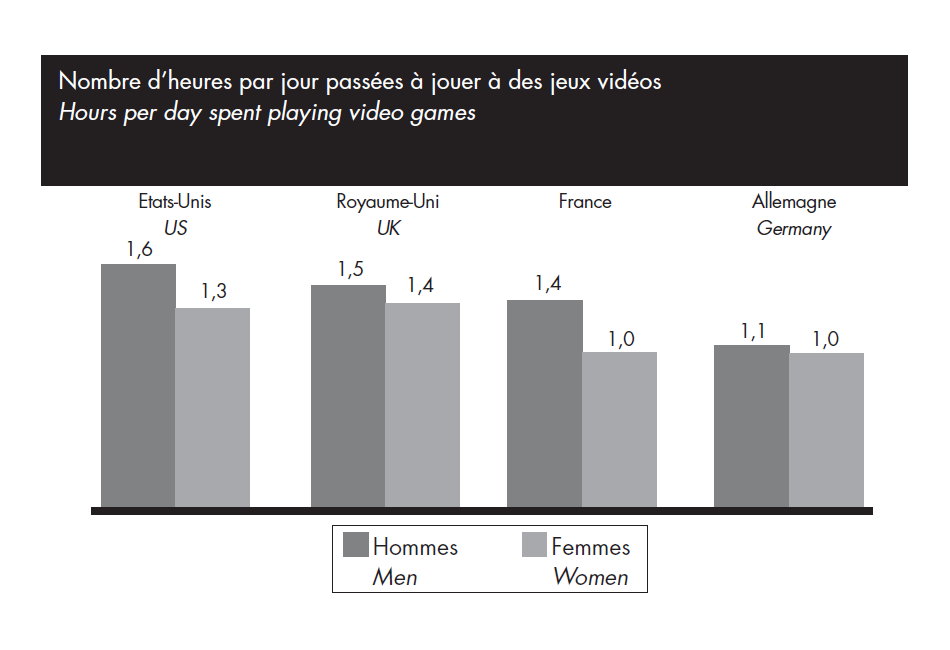
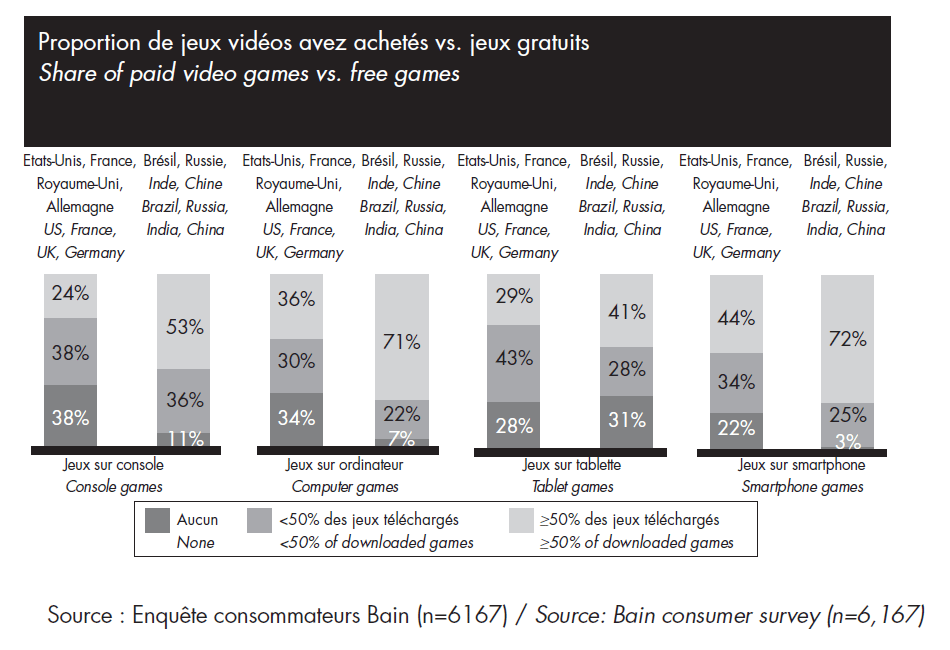
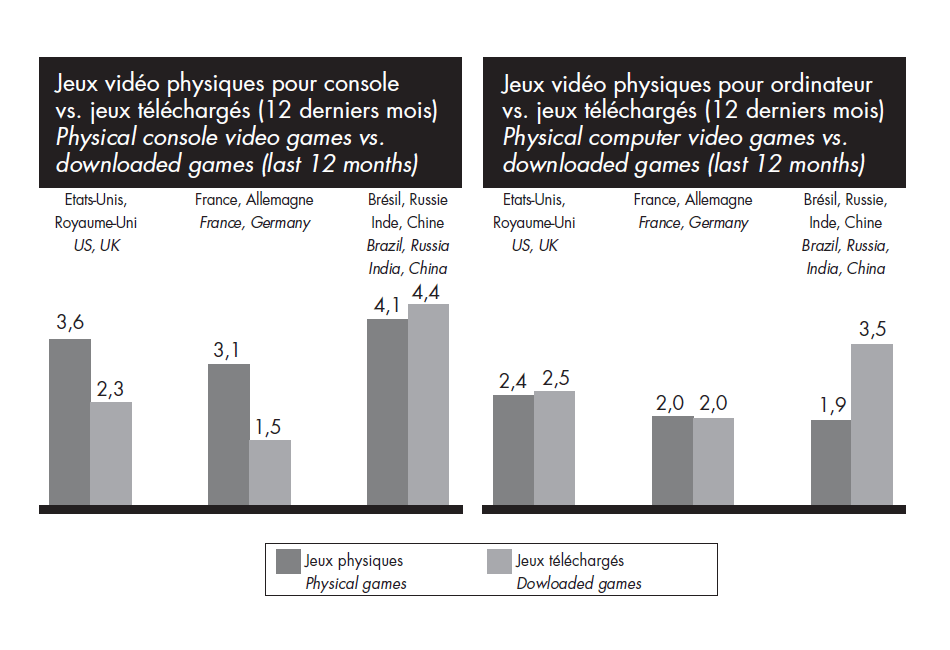
Notes on methodology
Bain & Company conducted an online survey in July 2012 with a panel of 6,167 people over the age of 15, including 1,018 in France; 1,000 in the UK; 1,000 in the US; 1,014 in Germany; 553 in Russia; and 582 in Brazil, who are representative of national populations according to gender, age, region and income, as well as 500 people in urban India and 500 people in urban China, who are representative of the urban populations according to gender, age and region.































